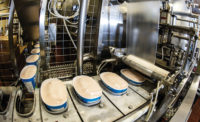The principles for producing nondairy frozen desserts from vegetable “milks” are the same as for conventional ice cream. However, the challenges are uniquely different. (In this article “milk” will refer to plant-based milks.)
Source materials include nutmeats, oilseed and grain. Table 1 shows the composition of the major sources. Compositional guidelines for frozen desserts using those sources are shown in Table 2.
The conditions and approaches under which “water extracts” of raw plant material are processed significantly affect the amount, type, functionality and sensory appeal of not only the resulting milk itself, but also the flavor, color and appearance of any frozen dessert formulated from it.
Nutritional claims
Formulation considerations depend on market positioning of whatever final frozen dessert is to be made and what is to be declared about the final product. That involves the nondairy feature as well as specific nutritional elements. These might include flaxseed and omega-3 fatty acids, oat beta-glucan and high-protein quinoa; declaration of true lactose-free or cholesterol-free; and low-fat or reduced-calories.
Flavor and color are more highly variable and problematic. Acid-type flavors (fruit flavors) do well but not without consequences seriously modifying both flavor and functional attributes of the mix. Non-acid flavors (vanilla, chocolate and vanilla/chocolate-based executions) are more difficult because flavoring elements may behave differently even if the same amount/type are used in dairy-based products.
Sweetness of any base milk will vary as well. The effect on milk composition can complicate selection of the amount and quality of added sweetness and flavoring. All this can affect mix processing and influences freezing, water mobility control, whippability and fat agglomeration. The latter can be beneficial (body/texture, heat shock resistance, meltdown behavior) or detrimental (greasy mouthfeel even at low fat levels).
Vegetable milk blends
Sometimes “filled” vegetable milks and the resulting mixes are more convenient and in certain instances less costly than using vegetable milk alone. These filled (or re-combined) milks are made from isolated, refined and/or otherwise concentrated vegetable sources of fat and solids-not-fat components, This approach involves easier formulation, more accurate and precise freezing point management, simplified mix making and more precise control of whipping/freezing, stiffness, flow properties, hardening and eating qualities.
When comparing nondairy frozen desserts to classical dairy-based frozen desserts, there are reasons why “matching” is both difficult and unfair. However, when done properly and in context, frozen desserts made from plant-based milk can be highly acceptable, even in the presence of fully standard ice cream and the like, which will forever be the gold standard.
Adapted from “Tharp & Young on Ice Cream: An Encyclopedic Guide to Ice Cream Science and Technology” (2012, Destech Publications) and “Tharp & Young on Ice Cream: Technical Short Course Workshops and Clinics” (North American Edition, 2013). For more, go to www.onicecream.com or call 610-975-4424 or 281-782-4536.





